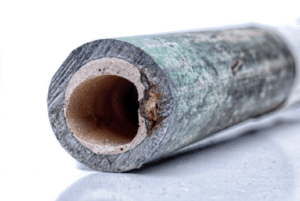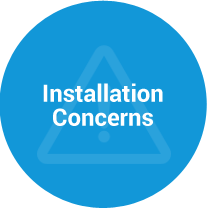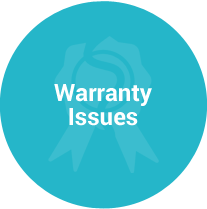Innovating Our Solutions and Our Website. As we introduce new solutions to better meet your needs, we’re also rolling out a new and improved website. Thank you for your patience during this time.
Epoxy Lining is a general term for a variety of different plastic resins used on hot and cold water supply pipes, sprinkler lines, HVAC piping, gas lines and certain drain, waste and vent piping. The National Sanitation Foundation (NSF) and U.S. Environmental Protection Agency (EPA) have certified some epoxy linings for carrying potable drinking water. Epoxy resins are generally not certified as a “structural improvement” to the existing piping system.
Click on the icons below to read more about the concerns and challenges of epoxy pipe lining.
Warranty Issues
Manufacturers’ Warranties

For several manufacturers, the warranty on their product is practically non-existent. If there is a defect, they will ship some epoxy compound to make a repair and no labor is covered, placing all the liability on the installation contractor. Others claim life expectancy of up to 50 years, though the industry is too new to substantiate such claims with actual installations. Lastly, warranties are limited based on water temperature, and voided if hot water systems are above certain levels (140 degrees Fahrenheit for several manufacturers).
Always confirm the warranties of both the manufacturer and the installer before making a purchase decision. In its own product literature, one manufacturer states: “Long-term durability of an applied epoxy lining depends on various factors related to resin formulation and contractor performance including:
- Physical and chemical properties of the epoxy material
- Proper surface preparation and cleanliness of pipe interiors prior to lining
- Quality of site application, including the stability of the mix ratio and curing conditions and,
- Sensitivity of the epoxy material to application condition
In view of these factors and their various potential combinations, it is apparent that the behavior of lining systems could differ greatly even within an individual rehabilitation, making assessment of an open ended statement of long-term durability difficult.” 18
Installers’ Warranties
It is important to understand how long the installer is offering to warrant workmanship in the event it is determined that they failed to properly install the lining product. In addition, it’s important to understand if the installer will match the manufacturers’ warranty if there is an issue with the product for which the manufacturers’ warranty only covers materials and not labor. Likewise, it’s important to understand if repairs covered under warranty; will be completed by a technician who is certified on the lining product that was installed. Locating a certified technician to perform a repair under warranty on a particular lining product could be a challenge in some local markets as most local service plumbers and maintenance personnel are not trained on working with lined pipes.
Bondability
For a number of reasons related to the requirements of the bonding company, pipe lining installers may not be able to obtain or provide payment and performance bonds. The key question to ask in this regard is: “Even though payment and performance bonds may not be a bid requirement, would a community feel comfortable hiring a contractor that does not have the ability to bond (obtain a third-party guarantee) their work?”
Epoxy Lining Conclusions
The overwhelming amount of risk associated with epoxy lining, coupled with observations of failed installations and their consequences, has led the authors to conclude that epoxy lining pipes within the building envelope is not a comparable alternative to pipe replacement. Before making an investment decision, it is always advisable for a community to explore all its options, including a repipe, to ensure their property is making the most informed decision possible about fixing its leaking pipes.










